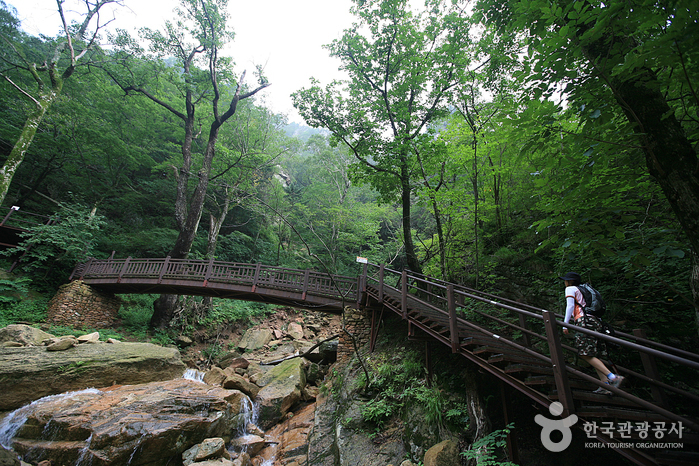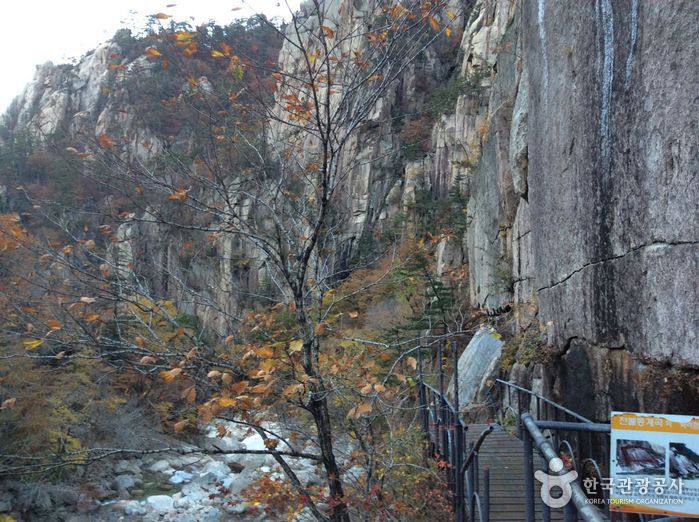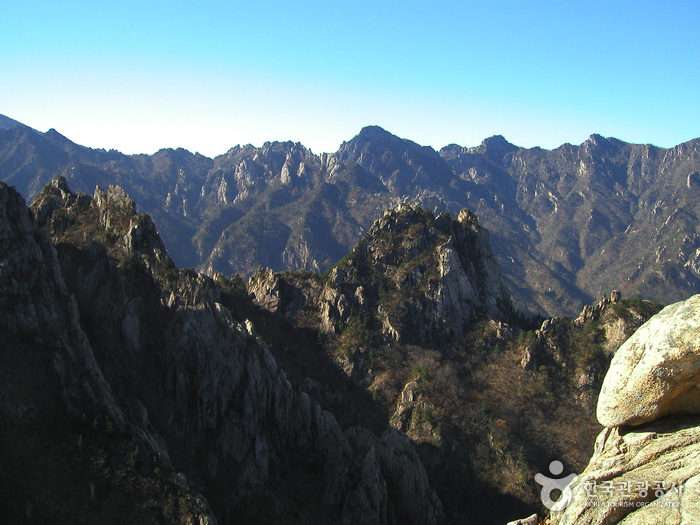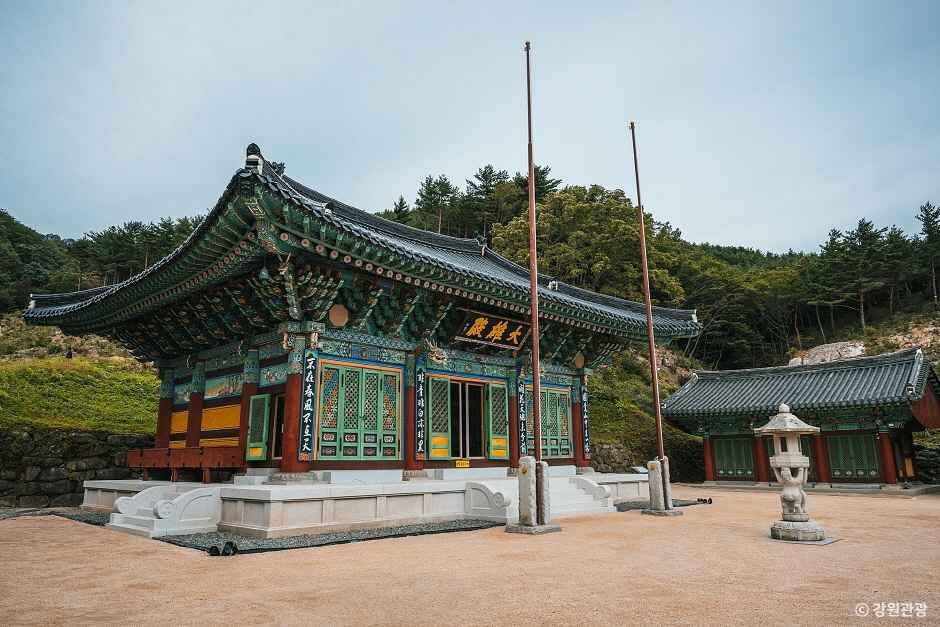Ulsanbawi Rock Milky Way Photo Spot on Old Misiryeong Trail (미시령옛길 울산바위 은하수)
9.4Km 2024-03-18
5110 Donghae-daero, Toseong-myeon, Goseong-gun, Gangwon-do
Misiryeong Pass, historically a pathway connecting Inje to Sokcho, also serves as an observation point for viewing Ulsanbawi Rock in Seoraksan Mountain. More recently, it has gained popularity as a photo spot for capturing the Milky Way. As a result, on clear nights, the parking lot is often filled with eager photographers.
Seoraksan Heullimgol Valley (설악산 흘림골)
9.4Km 2024-02-16
San1-71, Osaek-ri, Seo-myeon, Yangyang-gun, Gangwon-do
Yangyang’s Heullimgol Valley, named for its cloud-like, foggy appearance due to the surrounding high mountains and deep valleys, offers a spectacular view and serves as the gateway to Deungseondae. This spot provides an expansive view of the southern side of Seoraksan Mountain. Notable sites near Heullimgol Valley include Yeosimpokpo Falls, Deungseondae, Deungseonpokpo Falls, Geumgangmun Gate, and Jujeongol Valley. Access to Heullimgol Valley is strictly limited to 5,000 visitors per day, with entry based on time reservations. Therefore, visitors must make a reservation through the Korea National Park Service's reservation system before visiting.
Sinheungsa Temple (Seoraksan Mountain) (신흥사(설악산))
9.8Km 2024-03-12
1137 Seoraksan-ro, Sokcho-si, Gangwon-do
+82-33-636-7044
Sinheungsa Temple is a temple located in Seoraksan Mountain near Sokcho. It belongs to the Jogye Order of Korean Buddhism. It was originally founded as Hyangseongsa Temple by the monk Jajang in the Shilla dynasty (A.D. 652). Within the temple grounds, cultural heritage sites such as Geungnakbojeon Hall, a wooden structure from the mid-Joseon period, and the Three-story Stone Pagoda at Hyangseongsa Temple Site. The temple offers a templestay program where visitors can experience temple life firsthand. Participants can engage in various activities such as Buddhist ceremonies, Buddhist prayer, 108 prostrations, and lotus lantern and rosary making.
Cheonbuldong Valley (천불동계곡)
10.2Km 2021-04-09
1091, Seoraksan-ro, Sokcho-si, Gangwon-do
+82-33-801-0900
As one of the Ten Sights of Seoraksan Mountain, the Cheonbuldong Valley is also called Seorakgol Valley, being a representative valley of the mountain. Along the valley covering about 7 km from Biseondae Rock to Daecheongbong Peak, visitors can enjoy the splendid scenery of various attractions including Waseondae Rock, Munjudam Pool, Ihodam Pool, Gwimyeonam Rock, Oryeon Falls, and Cheondang Falls. It has all magnificent views of Seoraksan Mountain. The Cheonbuldong Valley is also regarded as one of Korea’s top 3 valleys along with Chilseon Valley of Jirisan Mountain and Tamna Valley of Hallasan Mountain. It offers beautiful seasonal views every year, and among them, the autumnal foliage is considered the best scenery of the valley. Its colorfully-tinged autumnal leaves are in harmony with rocks in fantastic shapes, attracting many hikers in autumn.
Biseondae Rock (비선대)
10.2Km 2021-04-09
1091, Seoraksan-ro, Sokcho-si, Gangwon-do
+82-33-801-0900
Biseondae Rock is a large rock located in the Cheonbuldong Valley of Seoraksan Mountain. The rock blended with a giant surrounding rocky wall creates a mysterious atmosphere. When it rains, water flows down through the rock and forms a small waterfall. The stream of water winding around the rock is considered the magnificent view, which is similar to that of the Manpokdong Valley in Geumgangsan Mountain. When the season changes, its landscape boasts different scenery: full-blown flowers in spring, green and refreshing trees in summer, colorful autumnal leaves in autumn, and white snowy view in winter. Due to such a mysterious landscape, Biseondae Rock bears a legend in which Taoist hermit called Magoseon enjoyed scenery of this place and ascended to heaven. The name of Biseondae, meaning the rock (dae) where a Taoist hermit (seon) flew up (bi) to the sky, originates from this legend.
Biryongpokpo Falls (비룡폭포)
10.2Km 2021-04-09
Seoraksan National Park, Seorak-dong, Sokcho-si, Gangwon-do
+82-33-801-0900
Biryongpokpo Falls is 2.4 km away in the south from the Seoraksan Small Park ticket booth. Biryongpokpo Falls is located between Towangseong Falls in the upper region and Yukdam Falls in the lower region. Biryongpokpo Falls was named after the shape of the water stream of the falls (pokpo) resembling a dragon (ryong) ascending (bi) to heaven. Their powerful water streams pouring into the narrow and rough valley look like a legendary dragon. There is another tale associated with Biryongpokpo Falls. A dragon lived here, and one day villagers offered a maiden to the dragon to break the drought. Then, the dragon flew up to the sky, and there were no more droughts in the village. The waterfalls drop 16 m to the ground and their loud sound resonates in the valley. In winter, the waterfalls freeze and the frozen water columns offer another magnificent view. A clear pond is formed beneath the falls and around which there is a wooden observation deck. Biryongpokpo Falls and Surroundings in Seoraksan Mountain were designated as the Scenic Site No. 95. It takes about 1 hr from the Small Park to the Biryongpokpo Falls, while it takes about 3 hr (round-trip) to visit up to Towangseong Falls and Yukdam Falls. The difficulty level of this tour course is ordinary.
Seoraksan Cable Car (설악산 케이블카)
10.2Km 2024-04-08
1085 Seoraksan-ro, Sokcho-si, Gangwon-do
A ride on the Seoraksan Cable Car is the best way to enjoy the unexplored regions of Seoraksan Mountain. The cable car station is located in Seoraksan National Park, and it takes about 10 minutes to reach Gwongeumseong Fortress, which is 700 meters above sea level. Since one-way tickets are not available, passengers must purchase a round-trip ticket. From the cable car window, passengers can see famous attractions like Ulsanbawi Peak and Manmulsang Rocks. From Gwongeumseong Fortress, passengers can take in a panoramic view of Seoraksan Mountain. Seoraksan Mountain, seen from the top of Gwongeumseong Fortress, is majestic and mysterious with unique rock formations. Upon reaching the top of the mountain, the entire scenery of Outer Seorak unfolds before one's eyes. Visitors will be amazed by the Allak Hermitage from the Silla dynasty and the Muhagsong Pine Tree, which has survived for hundreds of years just below Gwongeumseong Fortress. There are many tourists on weekends, public holidays, and fall foliage season, so visitors are advised to plan ahead.
Seoraksan Gwongeumseong Fortress (설악산 권금성)
10.6Km 2024-02-28
1091 Seoraksan-ro, Sokcho-si, Gangwon-do
+82-33-636-7700
Gwongeumseong Fortress is a stone castle from the Goryeo dynasty and is located 800 meters above sea level in Seoraksan National Park. From a distance, Gwongeumseong Fortress looks like a rising peak, while up close, the expansive stone floor and remnants of castle walls become visible. Visitors can access the fortress via hiking trails or by taking a cable car. From the fortress, visitors can enjoy the majestic view of Seoraksan Mountain and the blue waters of the East Sea.
Seoraksan National Park (Outer Seorak) (설악산 국립공원 (외설악))
10.7Km 2024-04-08
1 Daecheongbong-gil, Yangyang-gun, Gangwon-do
+82-33-801-0900
Seoraksan Mountain is renowed for its natural splendors and breathtaking views. It holds the distinction of being Korea's first UNESCO Biosphere Reserve and is also listed on the IUCN Green List. The mountain is divided into Inner Seorak, South Seorak, and Outer Seorak, which includes Daecheongbong peak (1,708 meters above sea level), ranking as the third highest peak in Korea. The area is celebrated for its popular hiking trails, with the sunrise and sunset views from the top being particularly spectacular.
Goseong Hwaamsa Temple (화암사(고성))
10.9Km 2025-12-16
100 Hwaamsa-gil, Toseong-myeon, Goseong-gun, Gangwon-do
Hwaamsa Temple was built during the Silla period, and then repaired many times throughout history, with the temple even moving locations to where it is now in 1864. The current structures were built in 1991 for the World Jamboree. The temple name also changed throughout history, with the current name being given in 1912. The temple is located in a pristine natural environment, and is home to a traditional tea house, making it a great place to relax and feel at peace.
◎ Travel Information to Discover Hallyu’s Charm - Variety Show "Summer Vacation"
Hwaamsa Temple is where actors Jung Yu-mi and Choi Woo-shik participated in a Templestay program on tvN's variety show "Summer Vacation." The two enjoyed a healing retreat through various temple activities, such as morning prayers and tea talks with Buddhist monks, finding peace of mind away from their daily routines. This tranquil temple is recommended as a special destination to rest your body and mind in nature’s embrace.





 English
English
 한국어
한국어 日本語
日本語 中文(简体)
中文(简体) Deutsch
Deutsch Français
Français Español
Español Русский
Русский